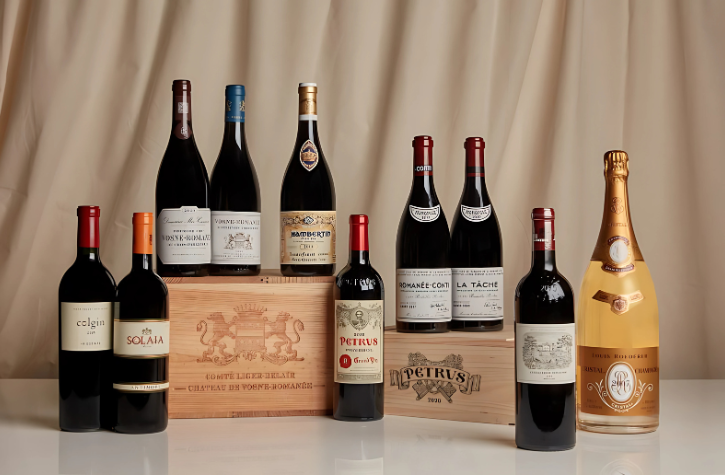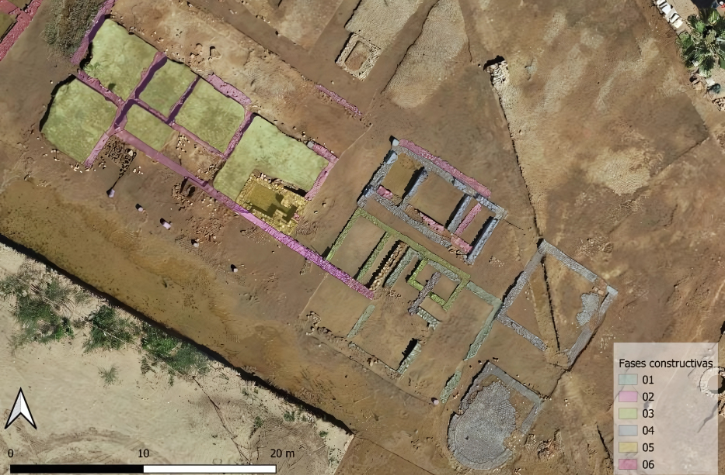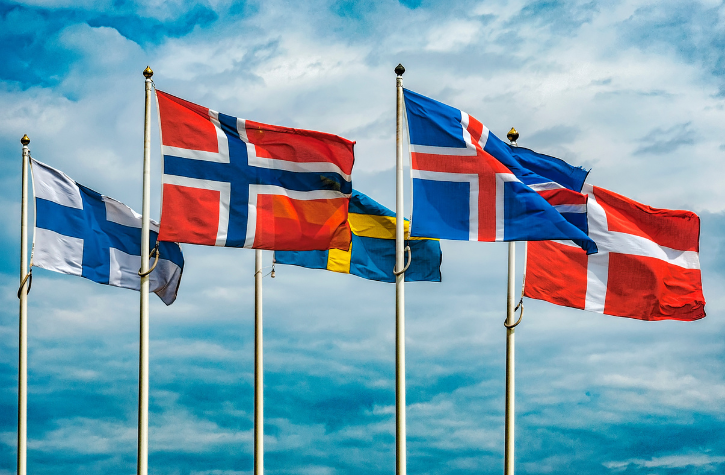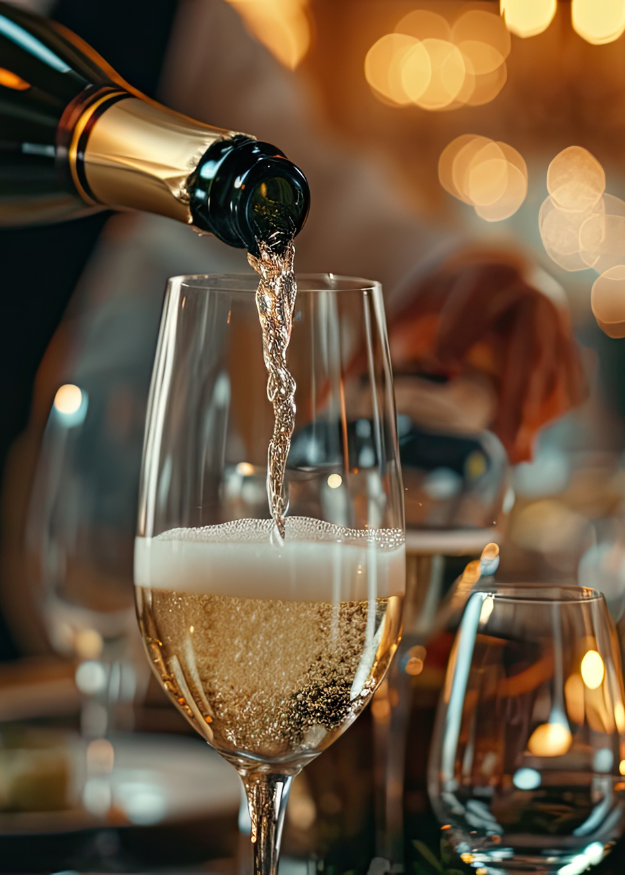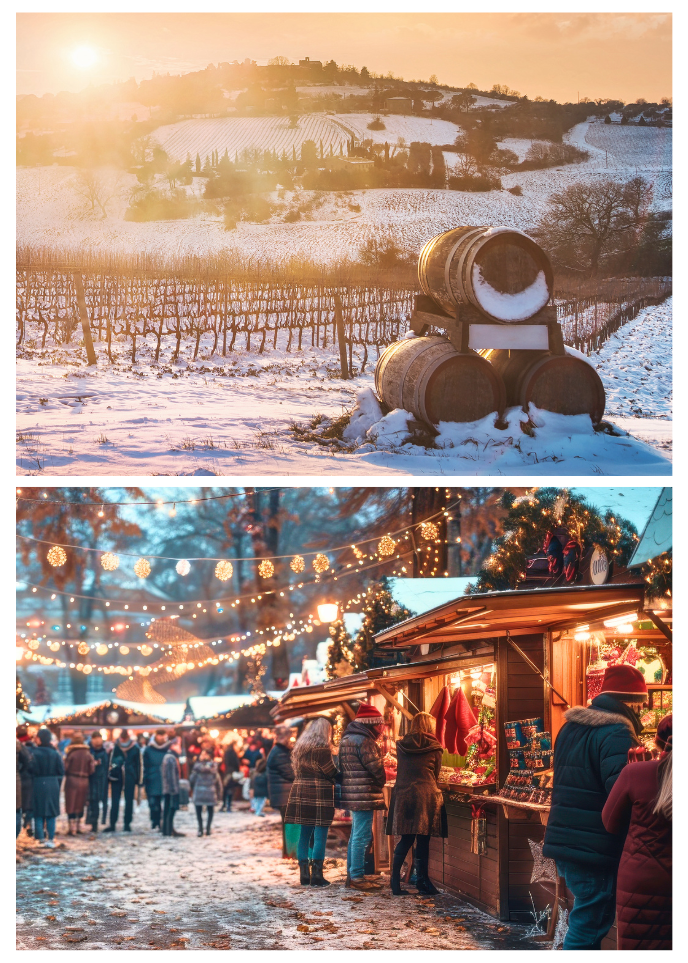2. Festive Sparkles
Celebrate the season with a theme dedicated to sparkling wines. These effervescent delights are perfect for festive occasions and can showcase a variety of styles:
- Champagne Brut NV (Champagne, France, Sparkling, Chardonnay/Pinot Noir blend)
- Prosecco (Veneto, Italy, Sparkling, Glera)
- Crémant de Loire (Loire Valley, France, Sparkling, Chenin Blanc)
- English Sparkling Wine (Sussex, UK, Sparkling, Pinot Noir/Chardonnay blend)
- Franciacorta (Lombardy, Italy, Sparkling, Chardonnay/Pinot Noir blend)
- Sparkling Shiraz (South Australia, Sparkling, Shiraz)
3. Winter Warmers
This theme highlights the wines that pair beautifully with the rich, hearty dishes of the season. These are perfect for cold nights and festive feasts:
- Rioja Reserva (Rioja, Spain, Red, Tempranillo)
- Amarone della Valpolicella (Veneto, Italy, Red, Corvina blend)
- Zinfandel (California, USA, Red, Zinfandel)
- Châteauneuf-du-Pape (Rhône Valley, France, Red, Grenache blend)
- Pinot Noir (Central Otago, New Zealand, Red, Pinot Noir)
- Tawny Port (Douro Valley, Portugal, Fortified, Blend of Indigenous Varieties)
4. Old World vs. New World
Explore the contrasting styles of traditional Old World wines and the innovative expressions from New World producers. Guests can compare:
- Bordeaux Blend (Left Bank, France, Red, Cabernet Sauvignon/Merlot blend) vs. Napa Valley Cabernet Sauvignon (California, USA, Red, Cabernet Sauvignon)
- Chablis (Burgundy, France, White, Chardonnay) vs. Yarra Valley Chardonnay (Victoria, Australia, White, Chardonnay)
- Chianti Classico (Tuscany, Italy, Red, Sangiovese) vs. Argentine Malbec (Mendoza, Argentina, Red, Malbec)
- Alsace Gewürztraminer (Alsace, France, White, Gewürztraminer) vs. New Zealand Gewürztraminer (Hawke’s Bay, NZ, White, Gewürztraminer)
- Cava (Catalonia, Spain, Sparkling, Macabeo blend) vs. Californian Sparkling Wine (USA, Sparkling, Pinot Noir/Chardonnay blend)
- Vintage Port (Portugal, Fortified, Blend of Indigenous Varieties) vs. South African Cape Tawny (Fortified, Blend of Varieties)
5. Classic vs. Modern Styles
Highlight how wine styles have evolved over time by contrasting classic and modern approaches to winemaking. Examples include:
- Classic: Burgundy Pinot Noir (France, Red, Pinot Noir) vs. Modern: Oregon Pinot Noir (USA, Red, Pinot Noir)
- Classic: Hermitage (Rhône Valley, France, Red, Syrah) vs. Modern: Barossa Valley Shiraz (Australia, Red, Shiraz)
- Classic: Pouilly-Fumé (Loire Valley, France, White, Sauvignon Blanc) vs. Modern: Marlborough Sauvignon Blanc (NZ, White, Sauvignon Blanc)
- Classic: Vintage Champagne (France, Sparkling, Chardonnay/Pinot Noir blend) vs. Modern: Grower Champagne (France, Sparkling, Single Vineyard Chardonnay)
- Classic: Sauternes (Bordeaux, France, Sweet, Sémillon/Sauvignon Blanc blend) vs. Modern: Icewine (Canada, Sweet, Vidal/Riesling)
- Classic: Madeira (Portugal, Fortified, Malvasia) vs. Modern: Australian Topaque (Australia, Fortified, Muscadelle)
6. Wines with a Story
Every bottle has a tale to tell. This theme focuses on wines with rich histories or unique narratives, making them perfect conversation starters:
- Beaujolais Nouveau (Beaujolais, France, Red, Gamay)
- Tokaji Aszú (Hungary, Sweet, Furmint)
- Barbaresco (Piedmont, Italy, Red, Nebbiolo)
- Dry Riesling (Clare Valley, Australia, White, Riesling)
- Blanc de Noirs Champagne (France, Sparkling, Pinot Noir)
- Sherry (Jerez, Spain, Fortified, Palomino)
Choosing a theme not only makes the evening more engaging but also gives you a framework for selecting your wines.
Selecting the Wines
Once you’ve settled on a theme, choose a selection of wines that offer diversity in flavour, style, and complexity. For a balanced tasting, four to six wines are usually sufficient. Start with lighter wines and progress to heavier or sweeter ones, allowing your guests’ palates to adjust. For example, a tasting might begin with a crisp Sauvignon Blanc from New Zealand, move through a rich Chardonnay from Burgundy, and conclude with a bold Cabernet Sauvignon from Napa Valley or a Port from Portugal.
When selecting reds or vintage whites, it’s important to open the bottles an hour or two before the party. Allowing the wines to breathe will enhance their aromas and flavours. For full-bodied reds like Barolo or Bordeaux, decanting can make a significant difference, softening tannins and revealing subtle complexities. Even certain vintage whites, such as aged Rieslings, can benefit from a little oxygenation to fully express their character.
Preparing the Tasting Experience
Serve wines at their ideal temperature to maximise their potential. Whites and sparkling wines should be slightly chilled, while reds should be served at room temperature. For a festive twist, include a mulled wine option to welcome guests as they arrive, setting a warm and inviting tone for the evening.
To ensure a smooth and enjoyable tasting, have all your materials ready in advance. Provide a wine glass for each guest, or multiple glasses if you plan on comparing wines side by side. Arrange the wines in order of tasting—usually starting with sparkling or light whites, moving to richer whites, and finishing with reds or dessert wines.
Pairing Wines with Food
Food pairings can elevate your tasting event, providing an extra dimension to the wines. Keep the bites simple and complementary, allowing the wine to take centre stage. A charcuterie board with a variety of cheeses, cured meats, olives, and nuts is a versatile option. For example:
- Pair a creamy Brie with a Chardonnay from California.
- Serve aged Cheddar alongside a Cabernet Sauvignon from Chile.
- Match a tangy goat’s cheese with a crisp Sancerre from France.
Include a few festive treats as well, such as dark chocolate truffles to accompany a Tawny Port or fruit tarts paired with a late-harvest Riesling. Small, bite-sized portions work best, ensuring guests can sample freely without feeling too full.
Adding Interactive Elements
Engage your guests with fun activities to make the evening even more memorable. A blind tasting is a great way to test palates and encourage lively discussion. Wrap the bottles in foil or place them in bags to conceal their identities, and challenge your guests to identify the grape variety, region, or vintage.
You could also encourage guests to score each wine on their tasting cards and vote for their favourite at the end of the night. Offering a small prize for the best guesser or most creative tasting note adds a playful touch.
Closing the Evening
End your tasting on a celebratory note by sharing a toast with your guests. A sparkling wine, such as a Blanc de Blancs Champagne or a sparkling rosé, makes for a perfect conclusion. To leave a lasting impression, consider sending your guests home with a small memento, such as a mini bottle of wine, a festive cork stopper, or even a handwritten thank-you note.
Hosting a holiday wine tasting party is an opportunity to combine seasonal cheer with the joys of wine discovery. With thoughtful planning, attention to detail, and a welcoming atmosphere, you can create an event that will be remembered long after the last glass is emptied.
